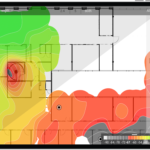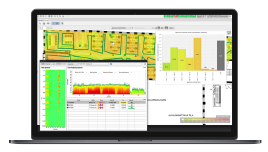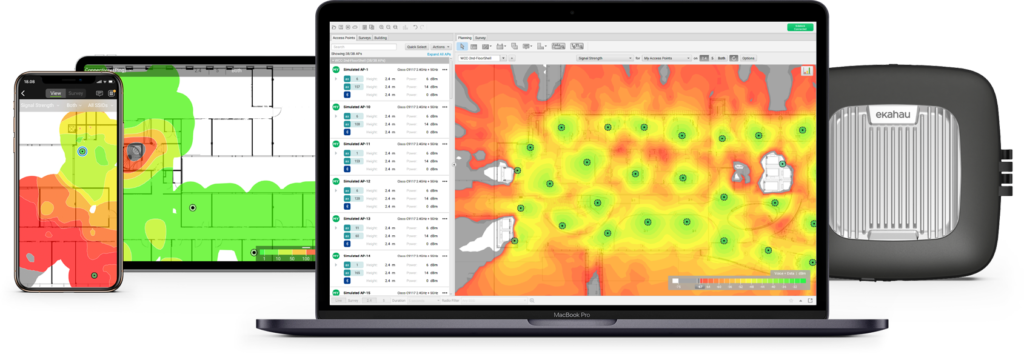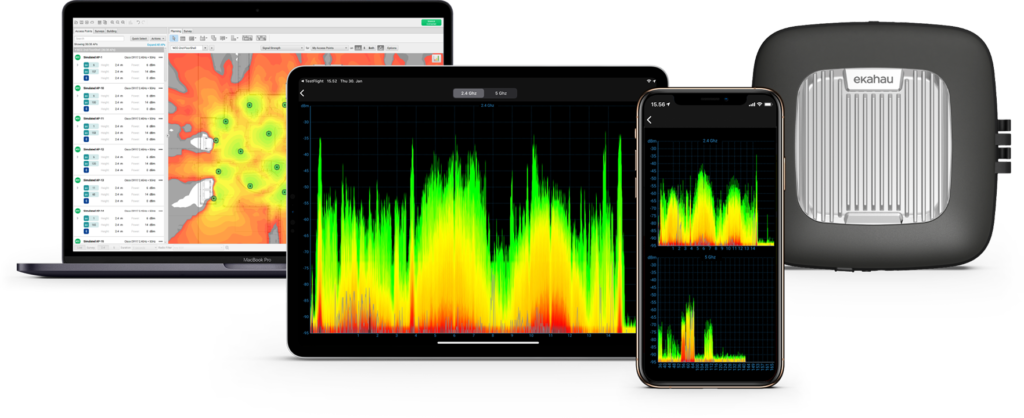The basis for a stable connection:
Professional WLAN site survey
No one would think of planning a complex building without an architect. Professional planning is just as important when installing a new WLAN network. Because this is the only way to ensure that the WLAN connection is built on a stable foundation. This is especially true in industrial environments, where the requirements are particularly high. One of the first and most important steps in this process is the WLAN site survey.

The “architect’s service” in a WLAN installation is the WLAN site survey. Your “architects” are our WLAN experts from Wireless.Consulting GmbH.
Alexander Bendler – Founder and owner of Wireless.Consulting GmbH
If you have problems with your existing network, our experts will help you with our special WLAN fault analysis!
WLAN site-survey is the foundation for a functioning WLAN

As a general rule, efficient work in a cable-free environment is only possible if the wireless network is reliably available. In order to successfully implement a WLAN network that meets all individual requirements, the conditions on-site must also be recorded. WLAN site survey provides the data necessary to install a permanently stable wireless connection on your premises. In the process, we carefully examine the building and structural conditions. In addition to your requirements, we also determine all conditions that could have a negative impact on the WLAN connection, such as redundancies, capacity, attenuation, penetration, interference, building, and structural conditions, existing frequency use, etc.
The individual phases of the WLAN site-survey
In the course of our WLAN planning, all conditions are recorded in a total of four phases, and the components and mounting locations that are relevant for the WLAN installations are determined. Furthermore, in addition to spectral analysis, each WLAN site survey always takes the possibilities of LAN and power into account. We work with Ekahau measurement software, for which we are certified.
- To start with, our experts first determine the requirements and the planned applications.
- We create detailed plans in our measurement software and simulate the WLAN coverage.
- On-site, we then validate the simulated data in a (so-called) Survey on a Stick (SoaS), record the location information for each installation point, and take photos.
- Lastly, we take the information obtained into account in the final planning of your individual WLAN when creating the documentation.

Phase 1:
Recording the requirements for your WLAN infrastructure
We create the basis for your reliable WLAN
The most important step in planning the WLAN infrastructure takes place even before the WLAN is rolled out. First of all, the desired functions are defined. We determine the quantity, movement, speed, data rate, and applications of your WLAN clients. In addition to the capacity, the roaming behavior of the WLAN clients is also taken into account.
Our services in this phase:
- Going through the WLAN check
- Review of the plans
- Recording the requirements
- Definition of WLAN parameters for signal, SNR, transmission power, installation variants, antenna variants, and device type
This way, we lay a professional foundation for the correct design/planning of your WLAN infrastructure.
Phase 2:
Simulation of the WLAN infrastructure
We plan for the practice
The basic plans for every high-availability WLAN network are created at the desk. So before we visit you, we simulate the ideal situation in theory. To do this, we study building plans, draw the structures and define the details. We also determine the materials and define the components that will be used. In doing so, we use either the components that are specified by you or those that are best suited for your WLAN connection – regardless of the manufacturer.
Our services in this phase:
- Integration and calibration of the building plans
- Drawing the building structure and defining the materials
- Defining the attenuation zones and coverage areas Simulation with a representation of the pre-defined parameters for ranges, data throughput, redundancies, channel planning
Our simulation always includes frequency planning and is based on your detailed building plans.
Phase 3:
Partial radio field measurement on site
We check our planning in your environment
The results of the simulation from phase 2 serve us as a guideline for the adjustment, i.e. the on-site measurement. Specifically, this means that we check the simulated coverage in your building. To do this, we place a specially configured access point according to the simulation and are thus able to measure the actual propagation including all sources of interference in your environment. In this way, we verify the presumed values, check sources of interference and determine the exact installation locations of all access points so that they guarantee the best connection.
Our services in this phase:
- Reference measurements SoaS per building to verify the simulation results.
- Inspection of the installation sites and recording of the local conditions
- Measurement protocol “radio field measurement” according to approved frequency bands
- Measurement protocol “Spectral analysis” (potential frequency interference sources)
We use reference access points in the 2.4 GHz and/or 5 GHz range.
Phase 4:
Radio network planning based on the measured data
We will design your WLAN
Theory and practical planning come together in the design of your WLAN. It contains a parts list with the required hardware such as access points, antennas, splitters, antenna cables, power supply as well as the installation instructions for each installation site.
Our services in this phase:
- Evaluation of the measurement results and adjustment of the channel planning
- Preparation of the measurement protocols including photo documentation of all installation locations
- Specific installation instructions in accordance with the conditions on-site
- Preparation of the quantity structure/parts list of the components to be installed
We prepare detailed documentation for each WLAN site survey, which we hand over to you after the final measurements.

The WLAN fault analysis:
The solution for problems in existing networks
If you are not able to work smoothly in your existing WLAN environment, this may be because your installations are faulty or not optimally implemented. It is also possible that external interference is affecting your wireless connection. In this case, our technicians can help you with a special WLAN error analysis including spectral analysis. We make the air visible, so to speak. The reasons for a poor connection are many and varied and not always obvious. They can lie in the WLAN itself, but just as easily in the LAN, in the authentication, or in incorrect prioritization. That’s why we extend our WLAN analysis to your entire network if necessary and subject it to a thorough examination. An IP packet analysis helps us to do this – and of course the trained eyes of our technicians
